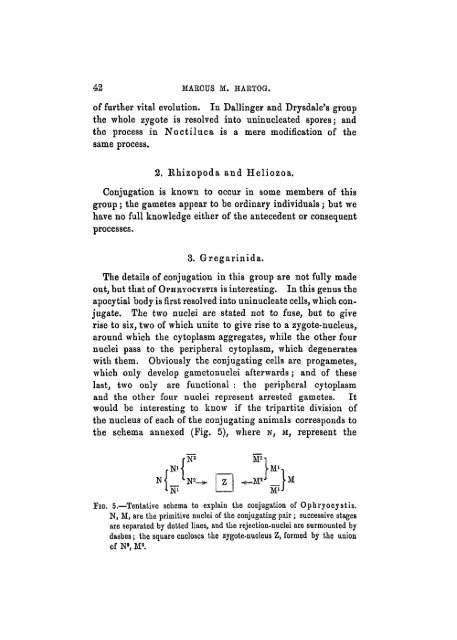Some Problems of Reproduction: a Comparative Study of ...
Some Problems of Reproduction: a Comparative Study of ...
Some Problems of Reproduction: a Comparative Study of ...
Create successful ePaper yourself
Turn your PDF publications into a flip-book with our unique Google optimized e-Paper software.
42 MAROUS M. HARTOG.<br />
<strong>of</strong> further vital evolution. In Dallinger and Drysdale's group<br />
the whole zygote is resolved into uninucleated spores; and<br />
the process in Noctiluca is a mere modification <strong>of</strong> the<br />
same process.<br />
2. Rhizopoda and Heliozoa.<br />
Conjugation is known to occur in some members <strong>of</strong> this<br />
group; the gametes appear to be ordinary individuals; but we<br />
have no full knowledge either <strong>of</strong> the antecedent or consequent<br />
processes.<br />
3. Gregarinida.<br />
The details <strong>of</strong> conjugation in this group are not fully made<br />
out, but that <strong>of</strong> OPHRYOCYSTIS is interesting. In this genus the<br />
apocytial body is first resolved into uninucleate cells, which conjugate.<br />
The two nuclei are stated not to fuse, but to give<br />
rise to six, two <strong>of</strong> which unite to give rise to a zygote-nucleus,<br />
around which the cytoplasm aggregates, while the other four<br />
nuclei pass to the peripheral cytoplasm, which degenerates<br />
with them. Obviously the conjugating cells are progametes,<br />
which only develop gametonuclei afterwards; and <strong>of</strong> these<br />
last, two only are functional : the peripheral cytoplasm<br />
and the other four nuclei represent arrested gametes. It<br />
would be interesting to know if the tripartite division <strong>of</strong><br />
the nucleus <strong>of</strong> each <strong>of</strong> the conjugating animals corresponds to<br />
the schema annexed (Fig. 5), where N, M, represent the<br />
M<br />
N<br />
i<br />
3<br />
_<br />
M l<br />
FIG. 5.—Tentative schema to explain the conjugation <strong>of</strong> Opbryocystis.<br />
N, M, are the primitive nuclei <strong>of</strong> the conjugating pair ; successive stages<br />
are separated by dotted lines, and the rejection-nuclei are surmounted by<br />
dashes; the square encloses the zygote-nucleus Z, formed by the union<br />
<strong>of</strong> N s , W.

















